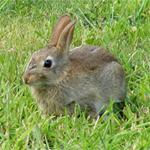Or search by topic
Number and algebra
Geometry and measure
Probability and statistics
Working mathematically
Advanced mathematics
For younger learners
Food Web



 A simple ecosystem consists of ample grass, a herd of 50 deer, a nest of 2000 rabbits, a cast of 10 hawks and a sleuth of 5 bears. Deer and rabbits are
herbivores, hawks only eat rabbits and bears eat both deer and rabbits.
A simple ecosystem consists of ample grass, a herd of 50 deer, a nest of 2000 rabbits, a cast of 10 hawks and a sleuth of 5 bears. Deer and rabbits are
herbivores, hawks only eat rabbits and bears eat both deer and rabbits.
Draw a food web, showing how the animals in this ecosystem are fed and what the transfer of energy is.
Discuss what would happen to the ecosystem if...
- The deer began reproducing rapidly.
- Some of the rabbits migrated out of the area.
- The bears were hunted by humans.
The average weight of the animals in this ecosystem is given in the table below:
| Animal | Weight |
| Deer | 150 kg |
| Rabbit | 1 kg |
| Hawk | 1 kg |
| Bear | 500 kg |
In the autumn, a bear needs to consume as much as 40kg of food a day as it prepares for its winter hibernation. A hawk will eat up to 1kg of food at a time, although it can then go without food for a day or two.
Rabbits reproduce quickly: a single female can produce up to 800 children, grandchildren and great-grand children over a season (February to October in the northern hemisphere, July to February in the southern hemisphere).
Is this eco-system sustainable over time?
You may also like
Plaiting and Braiding
This article for students gives some instructions about how to make some different braids.
Celtic Knotwork Patterns
This article for pupils gives an introduction to Celtic knotwork patterns and a feel for how you can draw them.
Logic, Truth Tables and Switching Circuits Challenge
Learn about the link between logical arguments and electronic circuits. Investigate the logical connectives by making and testing your own circuits and fill in the blanks in truth tables to record your findings.

